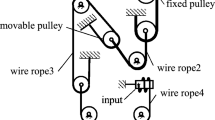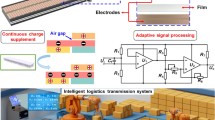Abstract
This paper proposes an automatic hitting-duration estimation method for a rechargeable impact wrench using a fuzzy neural network (FNN) to reach target torques. To manipulate a commercial rechargeable impact wrench to output a proper torque for a fastener and battery specification, an operator must determine the corresponding hitting duration based on experiences and experimental trials. Nevertheless, the determined hitting duration is fixed and cannot adapt to changes in battery voltage outputs affected by several factors, such as battery capacity and degradation, which leads to poor torque regulation. This paper addresses this problem by applying an FNN to estimate proper hitting durations to achieve target torques under different battery conditions. Without additional embedding of torque feedback sensors on the impact wrench, this paper feeds four easily available states as inputs to the FNN, including motor revolutions per minute, motor current, battery voltage, and target torque. Supervised input–output data are collected to train the FNN to estimate the optimal hitting durations for target torque regulation. The FNN-based hitting-duration estimation method is implemented in a microcontroller unit to control a real rechargeable impact wrench with different power sources. Experimental results show that proper hitting durations are estimated by the FNN under different battery conditions to control the rechargeable impact wrench to achieve different target torques.











Similar content being viewed by others
References
Wallace, P.: Energy, torque, and dynamics in impact wrench tightening. J. Manuf. Sci. Eng. 137(2), 1–8 (2015)
Zhou, J., Dai, S., Song, C., Zhang, A.: Development of an air impact wrench in a network-centric environment. In: Proceedings of 8th International Conference on Computer Supported Cooperative Work in Design, Xiamen, China, pp. 647–650 (2004)
Lee, J., Ko, D., Chun, H., Hur, D.: Control strategies for manipulating contact force of impact wrench to generate high level torque. In: Proceedings of 13th International Conference on Control, Automation and Systems, Gwangju, South Korea, pp. 1758–1765 (2013)
He, C., Wu, T.: Design, analysis and experiment of a permanent magnet brushless DC motor for electric impact wrench. In: Proceedings of International Conference on Electrical Machines, pp. 1591–1597 (2016)
Greenslade, J.: Impact wrenches are a bolt supplier’s worst enemy. Am. Fasten. J. 13(4), 29–30 (1996)
Jia, Z., Bhatia, A., Aronson, R.M., Bourne, D., Mason, M.T.: A survey of automated threaded fastening. IEEE Trans. Autom. Sci. Eng. 16(1), 298–310 (2019)
Deters, C., Lam, H.K., Secco, E.L., Würdemann, H.A., Seneviratne, L.D., Althoefer, K.: Accurate bolt tightening using model-free fuzzy control for wind turbine hub bearing assembly. IEEE Trans. Control Syst. Technol. 23(1), 1–12 (2015)
Liu, S., Ge, S.S., Tang, Z.: A modular designed bolt tightening shaft based on adaptive fuzzy backstepping control. Int. J. Control Autom. Syst. 14, 924–938 (2016)
Wu, Z., Zhang, G., Du, W., Wang, J., Han, F., Qian, D.: Torque control of bolt tightening process through adaptive-gain second-order sliding mode. Meas. Control 53(1), 1–13 (2020)
Miao, R., Shen, R., Zhang, S., Xue, S.: A review of bolt tightening force measurement and loosening detection. Sensors 20(11), 1–18 (2020)
Lee, J., Ko, D.S., Chun, H.H., Hur, D.J.: On the study of methodology of dynamic analysis for systematic designing impact wrench. In: Korea Society for Noise and Vibration Engineering, pp. 373–378 (2013)
Zhang, S., Tang, J.: System-level modeling and parametric identification of electric impact wrench. J. Manuf. Sci. Eng. 138, 1–16 (2016)
Drozdov, A.: Theoretical and empirical methods of estimating energy and force characteristics of impact wrenches. In: Proceedings of XXII International Science on Conference and Construction—The Formation of Living Environment, Uzbekistan, pp. 1–5 (2019)
Wettstein, A., Grauberger, P., Matthiesen, S.: Modeling dynamic mechanical system behavior using sequence modeling of embodiment function relations: case study on a hammer mechanism. Appl. Sci. 128, 1–17 (2021)
Noda, H.: Bolt-tightening method using an impact wrench. U.S. Patent No.05457866 (1995)
Fujinaka, T., Nakano, H., Omatu, S.: Bolt tightening control using neural networks. In: Proceedings of IEEE International Conference on Systems, Man and Cybernetics: e-Systems and e-Man for Cybernetics in Cyberspace, Tucson, AZ, USA, pp. 1390–1395 (2001)
Reilly, W.T.: Portable pneumatic impact wrench testing machine. U.S. Patent No. 08806961 (2014)
Woetzl, C., Bralla, D., Alberding, M.: Control method for an impact wrench. WIPO Patent No. 2017174415 (2017)
Grzejda, R., Parus, A.: Experimental studies of the process of tightening an asymmetric multi-bolted connection. IEEE Access 9, 47372–47379 (2021)
Ronald, L.: Method and apparatus for determining and adjusting torque in an electric impact torque wrench. U.S. Patent No. 05963707 (1999)
Alberding, M., Bralla, D., Orvieto, A.: Setting method for screw connections using an impact screwdriver. WIPO Patent No. 2019122189 (2019)
Juang, C.F., Chen, T.C., Cheng, W.Y.: Speedup of implementing fuzzy neural networks with high-dimensional inputs through parallel processing on graphic processing units. IEEE Trans. Fuzzy Syst. 19(4), 717–728 (2011)
Wu, M.F., Huang, W.C., Juang, C.F., Chang, K.M., Wen, C.Y., Chen, Y.H., Lin, C.Y., Chen, Y.C., Lin, C.C.: A new method for self-estimation of the severity of obstructive sleep apnea using easily available measurements and neural fuzzy evaluation system. IEEE J. Biomed. Health Inform. 21(6), 1524–1532 (2017)
de Souza, P.V.C.: Fuzzy neural networks and neuro-fuzzy networks: a review the main techniques and applications used in the literature. Appl. Soft Comput. 92, 1–26 (2020)
Juang, C.F., Bui, T.B.: Reinforcement neural fuzzy surrogate-assisted multiobjective evolutionary fuzzy systems with robot learning control application. IEEE Trans. Fuzzy Syst. 28(3), 434–446 (2020)
Naderkhani, R., Behzad, M.H., Razzaghnia, T., et al.: Fuzzy regression analysis based on fuzzy neural networks using trapezoidal data. Int. J. Fuzzy Syst. 23, 1267–1280 (2021)
Juang, C.F., Chang, C.W., Hung, T.H.: Hand palm tracking in monocular images by fuzzy rule-based fusion of explainable fuzzy features with robot imitation application. IEEE Trans. Fuzzy Syst. 29(12), 3594–3606 (2021)
Duan, L., Shi, M., Huang, C., et al.: New results on finite-time synchronization of delayed fuzzy neural networks with inertial effects. Int. J. Fuzzy Syst. 24, 676–685 (2022)
Juang, C.F., Pan, G.R., Wen, C.Y., Chang, K.M., Wu, M.F., Huang, W.C.: A fuzzy neural network model for rapid prediction of optimal positive airway pressures in OSAS patients. IEEE J. Biomed. Health Inform. 26(4), 1506–1515 (2022)
Lee, C.S., Tsai, Y.L., Wang, M.H., et al.: Adaptive fuzzy neural agent for human and machine co-learning. Int. J. Fuzzy Syst. 24, 778–798 (2022)
AbuHassan, A., Alshayeb, M., Ghouti, L.: Detection of design smells using adaptive neuro-fuzzy approaches. Int. J. Fuzzy Syst. 24, 1927–1943 (2022)
Ilieş, A.I., Chindriş, G., Pitică, D.: A comparison between state of charge estimation methods: extended Kalman filter and unscented Kalman filter. In: Proceedings of IEEE 26th International Symposium for Design and Technology in Electronic Packaging, Pitesti, Romania, pp. 376–381 (2020)
Kong, X., Zhang, X., Bai, L.: A remote estimation method of smart meter errors based on neural network filter and generalized damping recursive least square. IEEE Trans. Ind. Inform. 18(1), 219–230 (2022)
Acknowledgements
This work was supported by the Ministry of Science and Technology, Taiwan, under Grant MOST 110-2221-E-005-082-MY2.
Author information
Authors and Affiliations
Corresponding author
Rights and permissions
Springer Nature or its licensor holds exclusive rights to this article under a publishing agreement with the author(s) or other rightsholder(s); author self-archiving of the accepted manuscript version of this article is solely governed by the terms of such publishing agreement and applicable law.
About this article
Cite this article
Juang, CF., Chen, YW. Automatic Hitting-Duration Estimation of a Rechargeable Impact Wrench Using a Fuzzy Neural Network to Reach Target Toques. Int. J. Fuzzy Syst. 25, 29–41 (2023). https://doi.org/10.1007/s40815-022-01387-9
Received:
Revised:
Accepted:
Published:
Issue Date:
DOI: https://doi.org/10.1007/s40815-022-01387-9




